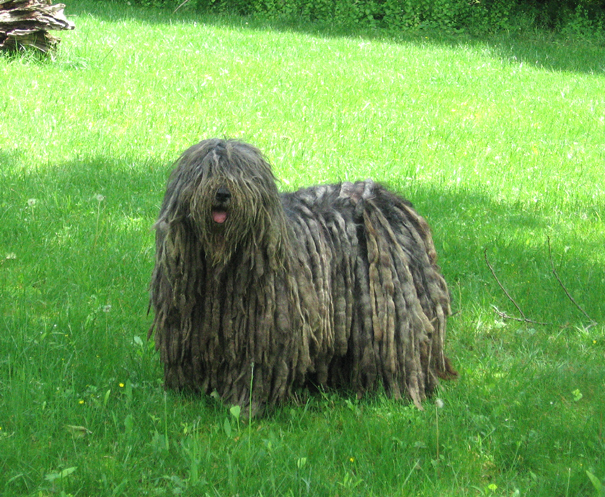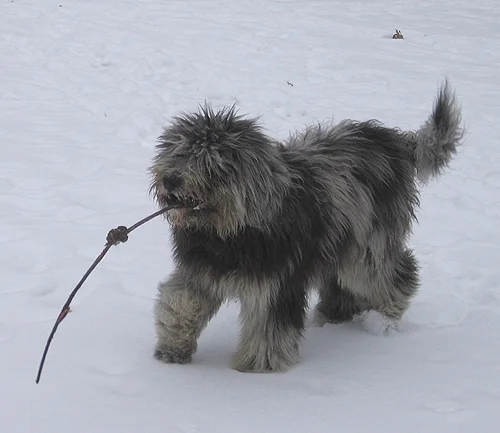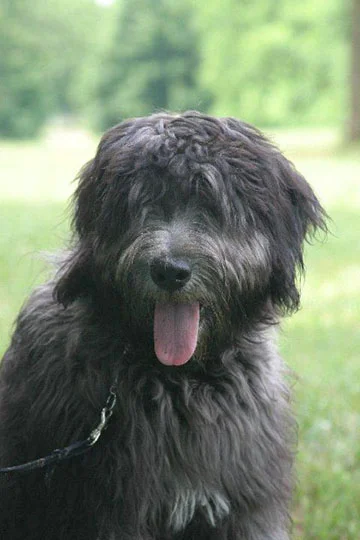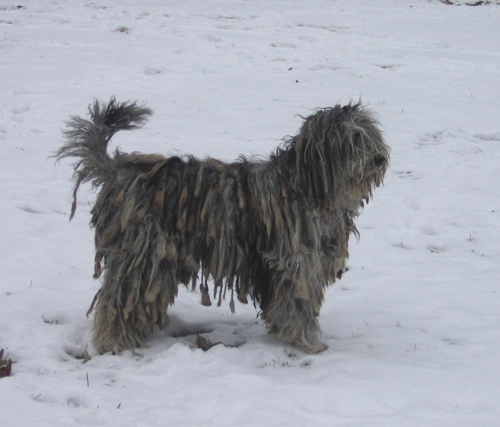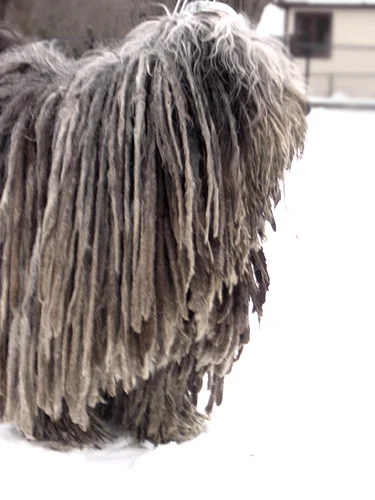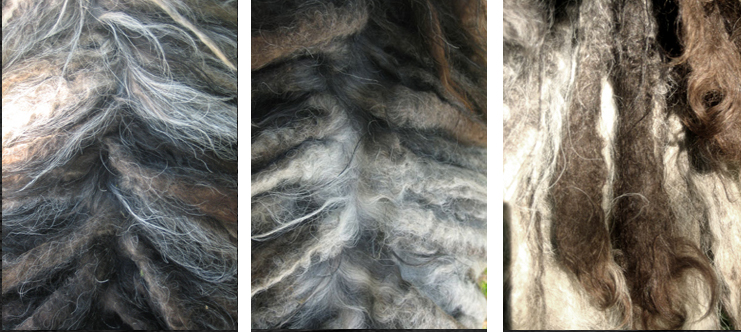Bergamasco Sheepdog coat and hair
When people first see a fully coated, mature, Bergamasco their initial reaction usually is: "How do you take care of that coat, and do you really sit there and weave the hair to make it look like that?".
Actually,
the Bergamasco coat requires very little care, except for the
occasional brushing and bathing. You can even brush The Bergamasco, when
the dog is mature and the hair has flocked together!
The Bergamasco
coat is forever changing, from the adorable, soft, fluffy, puppy coat to
the beginning flocking stage which may start as early as 8-9 months -1
year old. When this flocking starts, (which I call the tangled, messy
look), it lasts till the dog is approximately 18 months old. At
approximately three years old, the look that everyone has been waiting
for, has finally arrived!
The Bergamasco's coat is made up of hair, not fur and is considered to be non-shedding. I would like to make it clear that the Bergamasco hair does not cord, (cording is the twisting of hairs together to create a spiral strand). The Bergamasco coat is very different, in that the strands of hair weave together creating flat layers of hair, (called flocks). The definition of a flock is (a tuft or lock of wool or hair). Each flock of hair ranges in width anywhere from inch and half to three inches wide.
Before we can discuss each stage of coat development, one must first understand the formation of the coat. The coat is made up of three types of hair: 01. The Undercoat, fine dense and oily (not greasy) to the touch which forms a waterproof, protective layer. 02. The Goat hair which look like thin gray strands is strong and harsh similar to coat of a goat. 03. The Woolly top coat, which is finer and softer to the touch. The combination of the wooly hair mixed with the goat hair weave together to create the flock.
Different Stages Of Coat Care
Birth To Approx. 1 Year:
Each dog develops at their own rate depending on the dogs genetics. Whether you have a gray or black coated puppy, coat care is still the same. It is okay to wash your puppy once in a while or when the need arises, however, frequent bathing will dry out your puppy's skin and coat by removing the protective essential oils that keep the skin healthy and the coat clean. It is also important to keep your puppy free of any tangles or matting especially in the beginning, when the puppy coat is still present and the change over has not occurred. A monthly brushing with a pin brush will remove most tangles and debris.
At around 8-10 months you will begin to notice
the development of the longer smooth gray goat hair. This is the age the coat begins to get thicker especially around the base of the tail. You will begin to notice thin smooth strands of gray hair along the back and base of the dog. This is what we call the goat hair. Now the beginning stages of flocking can occur.
The goat hair together with the under coat and the wooly coat come together to form shapeless clumps of immediate concern for the first time Bergamasco owner. All of a sudden most Bergamasco owners panic at this initial matted, flocking that can be felt near the skin, more than seen by the eye.
Most owners have found these initial flocks by having their brush no longer usable in the hair. From this point on it is very important to put aside the brush and manually groom your Bergamasco by running your fingers through the dog's coat while relaxing in the evening.. Your dog usually prefers your touch over any hand held tool and is an excellent way to form a close bond with your Bergamasco.
Sometimes in the early stages of the development of the flocks, there can be more wooly hair than usual, causing the softer finer puppy hair to matte close to the skin. This type of matte should not be at this stage. It is important to separate these areas by hand as though true flocks are taking shape so the skin is not pulled. When the flocks begin to take shape, you will notice the base of the flock at he skin is never woven, but is straight non woven strands of hair. This naturally creates a space between the dogs skin and the beginning formation of the flock so as not to pull the skin and also allows air to the dogs skin.
It is not important to worry about the shape or direction of the mats when tearing, but simply to avoid the coat from forming a solid matte over the body. It is important however at this stage not to make the flocks to thin, for eventually the thin flocks can break and fall off. It is better to have larger width flocks than smaller ones. As the Bergamasco flocks get longer with age, the shear weight of a too thin flock will cause it to break off or it can also be pulled off through typical dog play.
During the 1st year to almost 2nd year old your Bergamasco looks unkempt and you may hear some pleasant comments, why don't they groom their dogs.
A Bergamasco with a lot of wooly coat can be a quite an adventure, constantly splitting and re splitting the coat to help set up the initial flocks. Many Bergamascos have coats that require minimal initial or ongoing care. Believe it or not once you have set the initial flocks they are taking shape everyday as your dog matures. Remember each flock will be different in width and texture depending on how the ratio of the three different type of hairs intertwine together.
On a typical Bergamasco's body you will notice the distribution of various types of hair is not constant. On the base of the tail, rear section of the trunk and the limbs, there is a vast amount of woolly hair. You will generally notice woolly hair throughout the dogs coat with the exception of the shoulders to the thorax where there is only goat hair and the hair in this region has a smoother texture.
Potential Trouble Spots:
Generally speaking when The Bergamasco is
starting to flock, check throughout the body, down to the skin, by
separating the hair with your hands to make a visual inspection. During
the first year large mats can develop behind and underneath the ears and
need to be torn into smaller flocks by hand. The limbs and chest need
to watched carefully as well. We also check underneath at the front and
back arm pits to make sure there aren't any mats pulling the skin. The
same method applies, tear too large groupings into thinner flocks by
hand.
Two - Three Years Old
This is the period when the dog's flocks begin
to appear separated and will have a flat fan like appearance in shape
and are visibly noticeable on the top line, although short in length.
One must watch carefully for the flocks not to become to thick or wide
or to thin.
If the flocks become to wide it is important to separate
them into the chosen width using the previously discussed method of
tearing from the loose top end, down to the skin. The splitting of the
too large flock should always be done by the hands, however, if need be a
scissors will work as an extreme last resort.
This is the period when the dog's flocks
begin to appear separated and will have a flat fan like appearance in
shape and are visibly noticeable on the top line, although short in
length. One must watch carefully for the flocks not to become to thick
or wide or to thin.
If the flocks become to wide it is important to
separate them into the chosen width using the previously discussed
method of tearing from the loose top end, down to the skin. The
splitting of the too large flock should always be done by the hands,
however, if need be a scissors will work as an extreme last resort.
Three Yrs Old +++
Someone may actually come up to you and comment, is that a Komondor or a Puli, Ah you say to yourself finally my Bergamasco is becoming a Bergamasco!
Once you have reached this period, it is home free,
so enjoy and watch as the flocks continue to grow throughout the dog's
life. As your dog matures, length and multi layers of flocks will
magically appear before your eyes. The Bergamasco coat at this stage
should now be with the flocks well developed, beginning from the top
line and eventually settling on the sides of body. If you find a flock a
little to thin you should do nothing eventually it may attach itself to
another one next to it. It is important though, to keep a watch on the
coat and split any flocks that become to too wide in width. One should
be aware that generally the flocks are not the same size everywhere on
the body of the dog. Generally, the flocks on the saddle and base of the
tail are thicker and wider due to the abundance of the wooly coat.
However, in areas around the shoulder and neck there is very little wooly hair only goat hair creating a smooth saddle.
On the chest the wooly coat is not as thick, therefore the flocks should be thinner and not as wide as those on the trunk of the dog. One must remember that the amount of wooly coat and goat hair various on different parts of the dog creating different size flocks throughout the dogs body as well as the dogs limbs, where the flocks should all be uniformed in size hanging loosely to the ground. On the head area around the eyes and muzzle, the hair is softer hanging loosely over the eyes. The hair should always cover the eyes creating a visor which protects the eyes from the sun rays. It usually takes up to five years for the Bergamasco coat to fully develop into layers upon layers of flocks that extend from the dogs shoulders to their paws.
Bathing:
The Bergamasco is generally a very clean dog, therefore it is only necessary to bath 2-3 times a year. The hair has natural oils which create a protective layer that help make the coat, water and dirt resistant. Without oil as natural protection the hair becomes dry and absorbs water as well as dirt more easily. The natural oils protect against dryness. When the need arises you can spot bath your dog in areas more frequent such as the whiskers, and under the mouth where food particles can accumulate. Other areas where dirt may be are the paws, fronts of lower limbs, underneath the dog and behind the tail area where you may find dry feces. When washing your Bergamasco it is important to use lots of water and gentle shampoos. There are now some excellent soap free shampoos on the market today, the advantage to a detergent based shampoo is that no residual detergent is left in the hair.
When washing the coat use plenty of warm water wetting all the layers of the coat especially the underneath layers. While rinsing, it is important not to leave any cleaning residue in the coat by constantly flooding the flocks with water while squeezing or twisting the flocks to help remove as much water as possible. The flocks, like a sponge absorbs a lot of water, the more water you can squeeze the faster the drying process will be. It is always best to bathe your dog on a breezy warm day, so drying time can be kept to a minimum, otherwise it can take two to three days to dry a full coated Bergamasco. If you use a cool dryer, never use a dryer designed for humans, the heat is too hot for dog hair and can severely damage the coat. It is best to use a commercial grooming dryer that offers different air flow attachments and have various temperature ranges.
Drying a dog with heavy flocks or cords.
As soon as you are done
bathing, start wringing out the flocks. If, in doing this, you raise a
lather, start over and rinse some more. Wring out the flocks until hands
cramp. Time spent here shortens the time spent being dried. Then use
long sleeve sweatshirts (cotton type from your High School or one that
you will pick up in yard and garage
sales, or from your kid's
closet….) One sweatshirt goes on over the head in more or less standard
fashion, and the other one over the other end, pretending the tail is a
head also. This will nicely wrap him up. Towels don't work for this.
Sweatshirts do. Use a couple of diaper pins to hold the two together.
Let these stay on about 10 minutes, you can repeat this with new shirts 2 more
times for fastest result. If you do these things, the drying time will be cut by
approximately 70% .
You can also use a hand wet/dry vacuum to remove some additional water as another way to reduce your drying time.
I like to bath our dogs on a warm sunny day and let them dry in from of a fan in the sun. The length of time he needs to stay in front of the fan will depend on the form of the cords - how densely each flock is packed. Never use heat for drying a dog. Use high powered wind. The safest and most comfortable drying is as follows: Choose a sunny warm day. Outdoor drying is better than indoor, so the damp air is not recycled by the fan. Line the bottom with towels or cotton quilts that will suck up water.
Use 1 or 2 fans, you can move them around around as the dog dries)….
Place
the dog in the X pen (or large crate) and position the fans, turn on and let the dog dry. Once in a
while you can come and move the fans and change the bottom towels.
If you don't dry him thoroughly, in 2 or 3
days, bacteria will bloom inside the warm, damp centers of the flocks,
and your dog will reek of mildew. It'll be much worse than he smelled
before the effort and agony of the bath. After you've removed your guy
from the drying cage, check him again in a few hours to see if capillary
action has pulled moisture out to the dry outer layers from still wet
inner layers. If so, in again for another a couple of hours or so.
Brushing
Many people ask, can you brush that coat? The answer is yes. An adult Bergamascos as well as a puppy can be brushed.. A puppy should have a monthly brushing to help remove small tangles and debris. A pin brush should be used to brush the puppy coat. A pin brush will not harm the coat or take out the undercoat. A slicker brush can be used during on a fully flocked and coated Bergamasco. The slicker brush will not damage the dense adult flocks, it will only remove the surface dirt that settles on the outside of the flocks. . It is also very healthy to brush the adult coat occasionally, at this stage the adult dogs seem to enjoy the brushing and it helps keeps the coat nice and tidy.
There is nothing more beautiful then the watching the movement of the Bergamasco with all it their flocks flowing through the air. I have always said that the Bergamasco unlike other breeds is always changing year after year, from the adorable, fluffy puppy stage, to the tangled youthful rebel stage, to the Beautiful Mature Majestic Bergamasco, as we have come to know and love.

